Sat 29 Apr 2017
Music I’m Listening To: DELANEY & BONNIE – Home [Complete Album].
Posted by Steve under Music I'm Listening ToNo Comments
Home was Delaney and Bonnie Bramlett’s first album, released by Stax in 1969.
Sat 29 Apr 2017
Home was Delaney and Bonnie Bramlett’s first album, released by Stax in 1969.
Fri 28 Apr 2017
WILLIAM RUSHTON – W. G. Grace’s Last Case, or the War of the Worlds, Part Two. Methuen, UK, hardcover, 1984; paperback, 1985. No US edition.
[England in the 1890s], the War of the Worlds is at an end, with the earth and its microbes victorious. Castor Vilebastard (pronounced “Villibart†according to Vilebastard, but we know better), about to bowl to W. G. Grace, the world’s foremost cricketer, collapses on the pitch at Lord’s, an Apache arrow in his back.
This novel is what may be called a reverse roman à clef — that is, there are fictitious people going about under real names. There are also real people using their real names.
Some of the more active real people — there are scores of them — are Grace, Dr John Watson, Inspector Lestrade, Mrs Hudson, Oscar Wilde, Toulouse-Lautrec, and Professor Moriarty. The fictitious people, among others, are Dr Henry Jekyll, along with his compatriot, Mr Hyde, and A. J. Raffles. Lord Greystoke makes a brief appearance.
Sherlockians will, of course, be fascinated by this new adventure of Dr Watson’s although they may be outraged when they note the suggestion that he has it off with Queen Victoria. They may also be puzzled by Watson’s introducing himself to Grace as “John D. Watsonâ€, as if there weren’t enough problems with the good doctor’s name. To add to the confusion, Watson claims he saw Moriarty vanish over the Reichenbach Falls. And, unfortunately, Watson is portrayed as more than a bit of a nitwit, which he never was.
Still, the author makes up for these strange statements by telling us, albeit too briefly, how Holmes, with Watson’s inadvertent aid, was responsible for the ultimate defeat of the Martians.
To enjoy this novel, no reader need be aware of what a silly mid-on or even a silly mid-off does on the cricket field. What is essential to bring to it is an appreciation of delightful farce, verbal slapstick, and good bad puns as Grace, Watson, and allies pursue Pollux Vilebastard, twin brother of Castor and an even bigger villain than Moriarty, to find out just what in (and out of) the world he is up to.
The Times Literary Supplement called this “a comic tour de forceâ€. A typical English understatement, I’d opine.
Biographical Note: From his Wikipedia page: “William George Rushton (18 August 1937 – 11 December 1996) was an English cartoonist, satirist, comedian, actor and performer who co-founded the satirical magazine Private Eye.”
Fri 28 Apr 2017
SING AND LIKE IT. RKO, 1934. Nat Pendleton, Zasu Pitts, Edward Everett Horton, Pert Kelton, Ned Sparks and John Qualen. Written by Aben Kandel and Marion Dix. Directed by William A. Seiter.
Sometimes in Hollywood they gave the stars a day off and turned the character actors loose on a movie, generally with happy results, and this is one of the happiest.
Nat Pendleton stars as a tough gang boss (“Youse guys are way down on yer kidnappin’s. And the Safecrackin’s off too.â€) married to a restless showgirl (Pert Kelton at her sharpest and sexiest). Early on, while cracking a safe in a Bank building, he overhears the Amateur Dramatic Society rehearsing their show and is captivated by Zasu Pitts singing an ode to Mother Love.
You can probably see it coming from here, but I’ll go on to say that Nat decides Zasu should go to the Big Time with a moving song like this, so he moves her into his penthouse, chaperoned by Ms Kelton — which is a bit like appointing John Waters to the Catholic Legion of Decency — and muscles in on Broadway’s leading impresario, played here by Edward Everett Horton.
These four play off each other like tennis pros doing mixed doubles: Pendleton’s genial ogre slamming up against Horton’s urbane jellyfish; Zasu’s innocence fluttering up against Pert Kelton’s sharp edges, and all of this propelled by a sharp script and brisk direction. I particularly enjoyed the bit where Pendleton decides the jokes in this show ain’t no good and has his boys write some… followed up many scenes later with the reaction of New York’s drama critics.
As if this weren’t enough, Sing is graced with the mugs of familiar character actors like Roy D’Arcy, Joe Sawyer, Paul Hurst and Bob Kortman. We also get Ned Sparks’ savage deadpan and a delightful John Qualen, perfectly cast as the lady’s wimpy beau.
There’s an interesting subtext here: Ms Pitts assumes that all show-people and gangsters are hell-bound degenerates and that sooner or later she will have to sacrifice her innocence for the sake of her art. And while she’s not exactly averse to the idea, there’s a charming moment when John Qualen declares, “I’ll still love you Annie — no matter how steeped in sin you are.â€
Come to think of it, this is a film full of charming moments, all of them served up with agreeable verve by a troupe of players obviously enjoying their time in the spotlight, and making things a lot of fun for the viewer. Catch it if you can.
Thu 27 Apr 2017
A song from this English rock band’s 1983 LP The Amazing Kamikaze Syndrome. An alternate version was released in the US in 1984 as Keep Your Hands Off My Power Supply/ “Run Runaway,” the first track on the latter LP, was the group’s first hit single in the US.
Thu 27 Apr 2017
LESTER DENT – Honey in His Mouth. Hard Case Crime #60, paperback original; 1st printing, October 2009. Cover by Ron Lesser.
I am sure that every review of this book is going to start the same way, so why should I be any different? Lester Dent, as far as he is going to be remembered, will be known primarily as the author of all but 20 of the 181 Doc Savage novels published in the pulp magazine of the same title in the 1930s and 40s. Unfortunately for Dent, only one of those stories were published under his own name. All of the others were as by Kenneth Robeson.
When Dent died in 1959, only 54 years old, he was attempting to shift over into writing hardcover mysteries, with only a small amount of success. This particular effort, I am told, was written in 1956 but was never published. What I have been unable to learn so far is why, or more precisely, why not.
It’s a tough, hard-boiled novel that I would say that most of the companies publishing tough, hard-boiled novels in 1956 would have accepted. If not Gold Medal, then there were quite a few others that (in my opinion) should have welcomed the chance to print this.
Walter Harsh, the leading character, is a tough one to sympathize with, though. He’s a small-time grifter, basically ignorant but far from stupid, making a few bucks here and there by selling people photographs of themselves through a bit of flim-flam and fancy talking. As the story opens, he’s being chased by a guy in another car who loaned him $712 worth of photo supplies on credit, money Harsh doesn’t have and can’t give back.
Speeding through the Missouri countryside at high speeds is not a great idea. After the crash, Harsh has one badly smashed arm, the one hanging out the window, and the other guy is dead, crushed under his car as it flipped over him a couple of times.
Recuperating in a hospital bed, with only his comely lady assistant Vera Sue at his side, Harsh is wondering about his future when the story really begins. Although it takes him a while before he catches on, Harsh is recruited to be a stand-in for a South American dictator whom he closely resemblances, down to the same rare blood type.
Apparently a revolution in the dictator’s country is in the works, and several of his close associates are making plans to dispose of the man and make off with the millions of dollars of cash and jewels he has stashed away.
Harsh’s cut? A mere $50,000, and unaware of the higher stakes involved, boy, does he want that money. He is the greediest, meanest, short on finesse son-of-a-bitch ever to get mixed up in a scheme like this. Not even the inclusion of one Miss Muirz, the dictator’s long-time mistress and in on the plot (see the cover) can keep his mind off what he has coming to him.
There is no explicit sex in this story, only some rough-handed violence, mostly at the hands of Harsh directed toward Vera Sue. Plans such as the one the dictator’s friends have hatched up seldom go well, at least in books, and so it is the case here. Harsh is a piece of work all right. It’s hard to remember another character anything like him, and Dent brings him to life to perfection.
Wed 26 Apr 2017
THE MURDER OF DR. HARRIGAN. Warner Brothers, 1936. Clue Club #6. Ricardo Cortez, Kay Linaker, John Eldredge, Mary Astor, Joseph Crehan. Based on the novel From This Dark Stairway, by Mignon G. Eberhart. Director: Frank McDonald.
Murder in a hospital has always been a staple of detective fiction, but perhaps even more so in the Golden Age of Detection, and here’s a prime example. Even before Dr. Harrigan’s body in found in a jammed elevator, there are all kinds of signs that this is a hospital to stay out of, no matter how sick you are.
Doctors light up cigarettes wills-nilly, for example, no matter where they are in the building, patients get up and wander around, including to each other’s rooms. Even worse, the sick man that Dr. Harrigan was going to operate on — and was last seen wheeling down the hall to an operating room — in a suit and tie yet — has completely disappeared. He’s nowhere in the building.
In the book, the detective of record is Sarah Keate, a nurse who was in seven of Mignon Eberhart’s novels, the last one appearing in 1954. In the movie, though, renamed Sally Keating (Kay Linaker), she doesn’t really do any detective work.
That’s left to the police and her would-be boy friend, Dr. Lambert (Ricardo Cortez) — he seems a lot more interested in marrying her than she is the other way around — and there are plenty of suspects to choose from, whether doctors, other nurses, patients, family members of all of the above, all acting very mysteriously.
Unfortunately, there’s no particular reason for picking on the actual killer to be the killer. I’m willing to wager that the book was a whole lot better in this regard. You watch the movie for non-stop action and banter, not for niceties of clues and actual detective work.
PostScript: The TCM website says that “Some of the other titles bearing the Clue Club stamp are The Florentine Dagger (1935), While the Patient Slept (1935), The White Cockatoo (1935), The Case of the Velvet Claws (1936) and The Case of the Black Cat (1936).”
Wed 26 Apr 2017
DOUG J. SWANSON – Big Town. Jack Flippo #1. HarperCollins, hardcover, February 1994. Harper, paperback, February 1995.
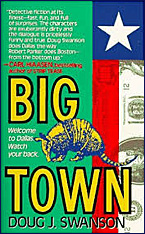
Jack Flippo is your basic seedy private eye. He wasn’t always, of course. Once he was an Assistant DA, but he screwed that up by following the dictates of an organ on the wrong side of his body. Now he works for an equally seedy lawyer, and makes it from one week to the nest. Barely.
A woman claiming to be the wife of a local motivational guru comes to the lawyer’s office, and wants a tape and picture of her husband with another woman. She gives him the time and place, and he sets up Flippo to do the dirty work. Flippo hears the girl being abused from the next room, and abandons the script and comes to her aid. Then things get complicated.
What this isn’t is your modern-day standard PI story. There isn’t a character in the book who isn’t dirty and scuffed, and there’s not an out and out good guy on the scoreboard. The action is an convoluted as a fractured skull, and you lose track of the double-crosses going on.
It’s a lot more like Cain or some of the Gold Medal boys mixed with Elmore Leonard than like Valin, Lyons, or Healy. He [Swanson] says he hasn’t read the Gold Medal guys, however, and though he’s read Cain, doesn’t regard him as a conscious influence.
Swanson’s got a decent eye for the down and out, and a pretty good ear for dialogue. He’s got the Dallas geography right, but there isn’t much feel for the city. Some of the characters ring true, and some, including a fairly major player, don’t. I don’t know that I believed all Flippo’s motivations and actions, particularly at the end. Swanson writes a different kind of PI novel, a 50s kind, and I do think he’s got promise.
Editorial Note: My review of Dreamboat, the second in the series — there were only five — appears here. Doug Swanson happened to see it, and he sent me a short note in response. You can find it here.
Tue 25 Apr 2017
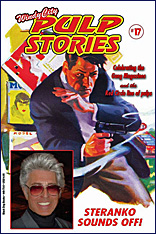
I believe there have been 17 versions of this excellent pulp and paperback convention and this may have been the best yet. 150 dealer tables and almost 600 attendees. This is the biggest crowd yet and the room seemed to be constantly busy with collectors prowling the aisles.
It all started with the usual group of serious and perhaps deranged pulp collectors driving out from New Jersey in a rental van. Between the five of us, we have more than 200 years of experience collecting books and pulps. In prior years we managed to make the trip in one death defying drive of 14 hours but this year we decided to split it up and take two days. The first day we drove about 11 hours before stopping at a motel which appeared to be connected to the Bates Motel in Psycho. The night clerk certainly thought we were a suspicious looking group because she refused our business and sent us on our way. Fortunately there was a Ramada Inn down the road and they were used to a van full of book collectors stumbling into the lobby.
The next day we drove three hours to the Chicago Pulp Art Museum, otherwise known as the house of Doug Ellis and Deb Fulton. Each year Doug and Deb have a pulp art luncheon for those collectors who love pulp and paperback original cover paintings. It’s a nice beginning to a great convention. Despite a recent addition the house is bulging with original art. Perhaps Doug can build another house in his back yard to house more paintings.
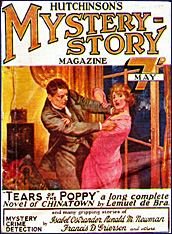
We then drove to the Westin Hotel and arrived in time to hang out in the Con Suite. This year my room was just down the hall on the 16th floor and made it easier for me to drink free beer and snacks. I renewed friendships with several collectors, most of whom I had not seen in a year or two. Unfortunately, I have now reached the age where I don’t recognize fellow collectors if I only see them once a year, so please accept my apologies if I ignored you or seemed to not recognize you. My eyesight is fading and old age is bothering the hell out of me, so several times I passed someone and then a minute later moaned “Oh hell, that was so and so, and I looked right through them.” Fortunately some collectors had canes or were limping or like Tony Tollin had a pet dog. That made it easier to recognize them….
Even all these years later, I still get excited when I enter a room full of books and pulps. At first I sort of stumbled down an aisle in a daze obviously suffering from sensory overload. But unlike a J.G. Ballard character, the books did not start to disappear from my sight. Instead they multiplied and I began to wonder which table to go to first. Should it be the table surrounded by cover paintings and art? Maybe the one loaded with vintage paperbacks? How about the boxes of digest crime and SF magazines? Damn it, there are rows and rows of pulps! Wait a minute, some old friends are waving to me…
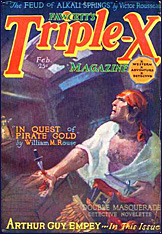
But then I saw a table that really stood out because all three dealers were British. So over I went to Malcolm Edwards, Alastair Durie, and Andy Richards (Cold Tonnage Books). I figured for them to make the trip across the Atlantic, they must be bearing some rare items. And they were! I even saw issues of the amazingly rare Hutchinson’s Adventure or Mystery magazine. WW II was really rough on some British magazines. (The paper drives.) But what I really scooped up were issues of Scoops, the 1934 British SF magazine. A complete set of all 20 issues.
Then I found twelve issues of Triple X. The title stands for the three genres of westerns, adventure, and detective fiction. Not the risque meaning that triple x has nowadays. Why this magazine is so rare is beyond me. It lasted for over 100 issues in the twenties and thirties and seemed to be quite popular with readers. Yet copies are hard to find and expensive.
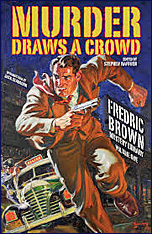
So OK, I’ve blown $1500 in a few minutes, and I still have three days of the convention to survive somehow. Will this be the pulp show that finally breaks me? Will I return home a penniless beggar? Will I have to borrow money, maybe skip meals? God Forbid, Go On the Wagon? The answer is no. Maybe next year. But I did find some more of my esoteric wants, such as Ace High, Cowboy Stories, Dime Detective.
Since we live in The Golden Age of Pulp Reprints, I filled up a box of recent books from Altus Press, Haffner Press, Black Dog Books, Murania Press, and also the book Weinberg Tales, which is almost 300 pages of Bob Weinberg on Collecting Fantasy Art, plus memories from fellow collectors like me and plenty of photos.
The reprint publishers have really done a great job and these recent books show an excellent sampling of the type of reprints. For instance Haffner Press (Haffnerpress.com) has just published two Fredric Brown collections which gather together all his mystery short stories. The titles are Murder Draws a Crowd and Death in the Dark, ,with introductions by Jack Seabrook who wrote a book on Fredric Brown. The stories also reprint the original illustrations. Highly Recommended!
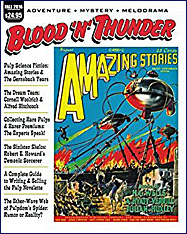
Altus Press had a boat load of books available and I especially recommend Leo Margulies: Giant of the Pulps by Philip Sherman and Gales & McGill, Volume One, by Frederick Nebel. A nice long introduction by John Locke, this book reprints the air adventures of these two flying soldiers of fortune. Also Altus Press has the latest two issues of Black Mask and Famous Fantastic Mysteries. The pulps are not dead!
Murania Press had the last issue of Blood n Thunder out. This is issue number 49 & 50 and it was a great run lasting 16 years. We now will see one shot issues on various topics. Also out from Murania is The Blood n Thunder Sampler which reprints some of the best articles from past issues.
Black Dog Books had several new collections out, and I liked The Trail of Blood and Other Tales of Adventure by Murray Leinster. Also Paths of Fire and Other Daring Tales of Adventure by Albert Richard Wetjen.
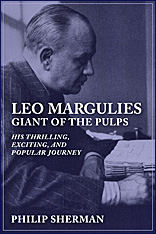
Every year the convention has a book titled Windy City Pulp Stories. Issue # 17 has several articles dealing with the Gangster pulps and the Red Circle Publications. Also pieces on Steranko, artist Tom Lovell, and David Kyle. Tom Roberts of Black Dog Books is the editor and does a fine job each year.
It’s worth going to this convention to meet and talk with other collectors about their passions. I’ve known artist Peter Poplaski for a long time and though he lives in France, I’ve seen him at several conventions. He is one of the top experts on Johnston McCulley and Zorro. This year he kept me amused with over a dozen masks that he had made of McCulley’s characters. He has now identified over 20 of them.
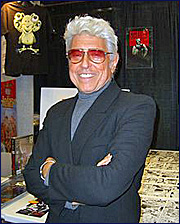
Windy City is known for its great auctions which run far into the night on Friday and Saturday, This year we had about 300 lots each night, mainly from the collection of Ron Killian. The catalog had a great photo of Ron Killian surrounded by towering stacks of pulps. Though I prefer book shelves, I can understand tall stacks also! All type of genres were represented in the auctions and the prices ranged from high to low, with many bargains.
The Guest of Honor was artist Jim Steranko, and he gave a speech and was available at his table to sign items. The art show was stunning with mainly pieces of art from the collection of Bob and Phyllis Weinberg. There was a Weinberg Tribute panel Friday night and I was honored to be part of it since I had known Bob since the late 1960’s and early 1970’s. In other words I was friends with Bob Weinberg when he still lived in New Jersey and was in his twenties. It really does not seem that it has been 45 years ago when we both started off building our collections.
Ed Hulse organized the film program as usual and the theme was “From Pulp to Silver Screen.” These were mainly obscure pulp related movies. Each movie was described in the Windy City Pulp Stories book.
We need this convention to keep the pulps alive so Doug Ellis, Deb Fulton, John Gunnison and others, all deserve our thanks. Next on the horizon is Pulpfest (Pulpfest.com) in July. If you liked Windy City, then you have to attend Pulpfest also. I ought to know, since I’ve been attending these shows most of my life!
Tue 25 Apr 2017
JAMES H. SCHMITZ – The Universe Against Her. Telzey Amberdon #1. Ace F-314, paperback original; 1st printing, 1964. Although not so stated, this novel is a fix-up consisting of two previously published stories “Novice” (Analog SF, June 1962) and “Undercurrrents” (serialized in Analog SF, May & June 1964). Gregg Press, hardcover, 1981.
There were in all a dozen or more Telzey Amberdon stories, all first appearing in Analog SF and over the years collected and repackaged in various shapes and forms, most recently by Baen Books. From all accounts they were very popular at the time, often gaining cover story status.
In this novel consisting of Telzey’s first two adventures, during the course of which she begins to gain knowledge and control of her one-in-a-million telepathic powers, she is only a 15-year-old girl going to law school. In “Novice” she manages to outwit her evil aunt who has plans of taking her pet away from her, a large cat-like animal Telzey has named Tick-Tock.
What the aunt doesn’t know, nor does Telzey, is that Tick-Tock is the only member of his race of telepathic beings who has remained visible on the planet of his origin, which is where Telzey is visiting her aunt. By communicating with Telzey telepathically, Tick-Tock also awakens her latent powers.
This is a good story, spoiled a bit by the lack of real motive for the aunt to do what she does, then by an ending in which Telzey fiddles with the aunt’s mind so that she no longer is a bad person. There ought to be law against that, is my thought, but apparently there isn’t.
There is also not a law against murder for hire, as it turns out in story number two, which in book form continues immediately after the first. In fact, quite the opposite is true and is legally called a “private war.” Once again it is a female relative who is the evil antagonist, except this time it is that of a good friend of Telzey at school, a girl who is about to come into an inheritance worth a lot of money, if she lives that long.
This one moves slowly, in one sense, since a lot is taking place, but a lot of exposition is used to explain what is happening. The way science fiction is written today, all of the action would be described with much more detail, with lots of dialogue to help move the story along, instead of longish paragraphs that summarize, telling not showing. It’s a good story, but to today’s readers, told in dull fashion.
Not much is made of Telzey’s age, by the way, nor even the fact that she is female, both facts which were, I think, quite remarkable for the time the stories were written. By the time this book ends, her psionic abilities, seemingly getting a quantum boost whenever needed, are very powerful indeed, but with a strong hint that even more adventure — and danger — lie ahead.
Mon 24 Apr 2017
GORDON D. SHIRREFFS – Rio Desperado [+] Voice of the Gun. Ace Double F-152, paperback originals, 1962. Both have been reprinted either separately or in combination with other novels.
When a cowpoke heads out across the pass to a neighboring valley to avenge the hanging death of his half-brother, events quickly grow out of control, and the young gunfighter whose life he saves three times in two days causes him more problems than he could ever imagine.
Only 102 pages in length, Rio Desperado feels cut off in its prime. Much of the anticipation that’s aroused by an interesting beginning is erased by an ending that’s far too rushed and confusing to be of any help. Who knows what evil the editor wrought?
Longer, but again only 120 pages long, Voice of the Gun is a better book than its other half, but only by the smallest of margins. The theme is the same, that of one man facing down almost insurmountable odds, heading into enemy territory to regain or to hold onto what is rightfully his.
And of course he succeeds, in spite of several stubborn, boneheaded mistakes and miscalculations on his part. And in spite of some fast-changing and sometimes surprising alliances and allegiances, the high point occurs when Sloan Sutro gets some additional support from sources it seems he had no right to count one. (In other words, this is a good story, almost in spite of itself.)
Comment: At one time I was working on a complete bibliography for Gordon Shirreffs, and I thought it was complete enough that I’d put it online. But if I did, I can’t find it now. I’ll have to look into the status of that. Even though these two novels were what I considered minor efforts, Shirreffs was one of the better western writers of his time.